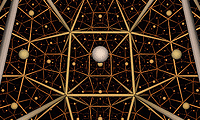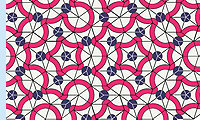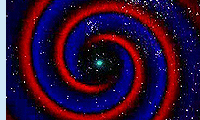Robin Hillier
(Univ. of Rome Tor Vergata, Italy) |
On super-KMS functionals for graded-local
conformal nets
Abstract:
We introduce super-KMS functionals for
graded-local conformal nets with superderivations, roughly speaking as
a certain supersymmetric modification of classical KMS states on local
conformal nets. Although we are able to make several surprising
statements concerning their general structure, most properties will be
studied in the setting of individual models. In particular, we provide
a constructive existence and partial uniqueness proof of super-KMS
functionals for the supersymmetric free field in d dimensions, for its
rational extensions, and for the super-Virasoro net. Moreover, we show
that super-KMS functionals - as one of their main applications - give
rise to generalized perturbation-invariant entire cyclic (JLO) cocycles
and thus to a connection with noncommutative geometry.
|
Nelson
Martins Ferreira
(Instituto Politécnico de Leiria, Portugal)
|
Topological spaces via neighborhood
relations and an appropriate notion of base
Abstract:
In the beginning of twentieth century,
motivated by the works on functional analysis and in particular by the
work of Riemann and the work of Poincaré, several attempts were made to
give, as general as possible, the notion of space. Today we have many
equivalent formulations for the notion of what is called a topological
space. In fact one of the most standard ones, that dominated the second
and third quartets of the last century, is the definition of topology
by means of open sets: a set equipped with a collection of subsets,
called opens, such that it contains the empty set, the whole set, and
is closed under finite intersections and arbitrary unions. This is
indeed the most general notion of a space in the sense that finite
intersections, together with the whole set are used to form product
spaces, while arbitrary unions are used to establish the connection
with the more intuitive idea of neighborhood. The alternative
definition via a system of neighborhoods is also well established and
in practice it is used as much as open sets, or, for that matter,
closed sets, closure operators, etc. Nevertheless, to this author's
knowledge, apart from the book [1], and their sequels, there is no
other place where the notion of neighborhood is primitive. This is
somehow surprising since in the Hilbert's proposal, from 1902, one of
the first ones in this direction, even before Frechet and Riesz ([2],
p.211), the notion of neighborhood is central. In this work we follow
Hilbert's intuition and introduce an alternative definition of a space,
based on the notion of a neighborhood relation.
It turns out that this equivalent definition of a topological space is
suitable to be internalized, as a categorical structure, and
furthermore it makes sense in an arbitrary topos. As a consequence of
this approach we can easily derive the notion for a base and consider
the category of bases for neighborhood relations, obtaining thus a
setting which is both intuitive and eficient.
References:
[1] R. Brown, Topology: A Geometric Account of General Topology
Homotopy Types and the Funda-
mental Groupoid, Ellis Horwood, 1988
[2] I. M. James, History of Topology, North-Holland, 1999
|









